
At least 7,715 women who live in Guanacaste are unemployed, according to data from the Continuous Employment Survey for the first quarter of 2023, prepared by the National Institute of Statistics and Censuses (Spanish acronym: INEC).
There are several reasons that keep them out of the workforce: They continue to be the ones who to take on household responsibilities; they don’t have the training necessary to fill the positions that are available; tourism, which is a driving force in the province, only offers them temporary jobs; and they don’t get adequate incentives to create their own business ventures.
In addition, 86,174 women aren’t part of the labor market because, even though many are students and retired women, a good portion of them run into the same obstacles of training, time and responsibilities at home that prevent them from deciding to have a job.
Analysts and leaders from institutions and organizations in the province don’t find any proposals, projects or public or private initiatives to believe that there will be significant actions to change that reality in the short term.
INEC data reveals that the Chorotega region ranks as the area with the greatest inequality in the country, according to the Gini Coefficient, which measures inequality in a population. In it, numbers close to zero indicate a greater level of equality between the people in that community and numbers close to one indicate the greatest inequality.
Guanacaste reached a “Gini” of 0.524 last year, which is an inequality much higher than that of the Central Region, which obtained a “Gini” of 0.486. According to data from the National Household Survey in July of 2022, the one most recently published by INEC.
This means that a few people receive the majority of the income and the others, who are the majority, get a much smaller portion of the Chorotega region’s financial income.
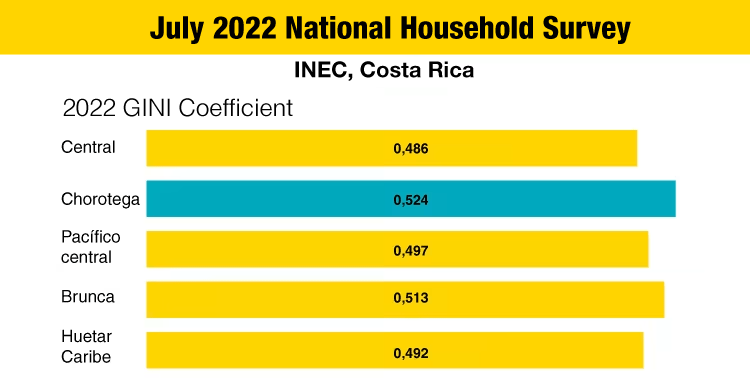
The National Employment Strategy announced by the government in July of this year in the province seeks to close some of these gaps, especially through training from the National Learning Institute (Spanish acronym: INA). However, the initiative does not foresee immediate results.
What are the obstacles to employment?
1- Limited production chains.
There are a variety of causes for female unemployment in the province. However, according to Xinia Carrillo, coordinator of the International Business and Commerce degree program at the National University (UNA) in Liberia, a predominant factor is the lack of business activities for production chains in strategic areas such as the Daniel Oduber airport, and there needs to be direct foreign investment that boosts employment.
“In the Chorotega region, the source of employment is through tourism and this tourism is temporary, so there are no sources of employment,” she pointed out.
The region is characterized by a labor market with greater employment in activities related to commerce, lodging and food services, as well as agriculture. These represent 39.2% of the jobs of the region’s employed population. This data is derived from the Ministry of Labor from the Continuous Employment Survey for the first quarter of 2022 and the National Household Survey for July of 2021.
María Picado, coordinator of the Public Policy Management department of the National Women’s Institute (Spanish acronym: INAMU), highlights gaps in the recruitment and selection of personnel and the digital divide as two of the main reasons that exclude women from employment. Added to these are others such as inequality in the use and control of time.
2- The nation doesn’t work on decentralization
Likewise, Esteban Barboza, coordinator and researcher from UNA’s Tourism, Immigration and Sustainable Development Observatory, Liberia campus, pointed out that the fact that there is greater unemployment in Guanacaste is due in part to the Costa Rican nation itself.
Historically the nation has been centralist; in other words, it has diversified the economy and opportunities in the Central Valley more and here in Guanacaste, they have prescribed tourism as if that were the final solution,” said Barboza.
In addition, he expressed his opinion about the type of tourism in Guanacaste. “Beach properties have increased by up to 400 percent. What does that mean? That it automatically excludes a huge number of people from being able to participate in the bid to buy and to build in these types of places. Since the places in those regions are appraised at so much, the cost of living automatically increases, rents increase,” pointed out Barboza.
Jessica Betancourt, 28, was a biology student, but due to lack of financial resources, she wasn’t able to finish her degree. She is currently unemployed and has had a hard time finding work.
She has worked as a kitchen assistant, in supermarkets and at restaurants. In the tourism sector, she worked as a waitress for a year in a restaurant in Nuevo Arenal on Tilarán. There, some workers have to depend on the seasons to get hired. “Normally in these types of work, they don’t always hire you all year round. That always depends a lot on the number of people who visit the place. In the low seasons, there are always staff cuts,” Jessica commented.
There are women who have completed degrees who can’t find work in their area or the salary isn’t appropriate. But in most cases, the jobs that there are are more for the bar sector as waitresses,” she added.
That’s the case for Ivannia Delgado, who has worked for 25 years in the tourism sector and commented that her coworkers help each other with English. She currently works in the kitchen at a soda (small restaurant) inside Hotel Riu, located in Sardinal de Carrillo.
“Before the pandemic, well, it was great. It was a well-paid job, it was nice. With the pandemic, well, everything has become a little complicated. Thank God and for the good of everyone, since everything is now picking up and we’re more normal now,” Delgado commented.
3- Work at home
“We know that due to a matter of socialization and culture, women are the ones who have the greatest burden of caring for people,” said Victoria Artavia, head of INA’s Consultancy for Gender Equity and Equality.
Vilma Segura, 57, a resident of Cañas, is dedicated to taking care of her second child and doing housework. Óscar José Sevilla is 35 years old and was born with Down Syndrome, completely dependent on someone for basic needs. Vilma finished high school and took a small cooking course. However, due to her son’s condition, the government provides her with a pension.
The woman has always been the one [responsible], and I think it’s the job of both, father and mother, to take care of their children. If I had had a father to help me, I would have perhaps gone out to work or at least to study something that I liked and do it for work, even if it was from home,” she commented.
In the Chorotega region, women spend an average actual time per week of 13 hours and 20 minutes caring for boys and girls under 12 years of age, while men spend less than half: 6 hours and 22 minutes. Likewise, the average actual time they spend caring for totally dependent people over 12 years of age is 13 hours and 20 minutes. Women don’t receive compensation for domestic work or for caring for dependents, which also makes it difficult for them to obtain paid employment. This was concluded based on data from the 2022 National Time Use Survey (Spanish acronym: ENUT).
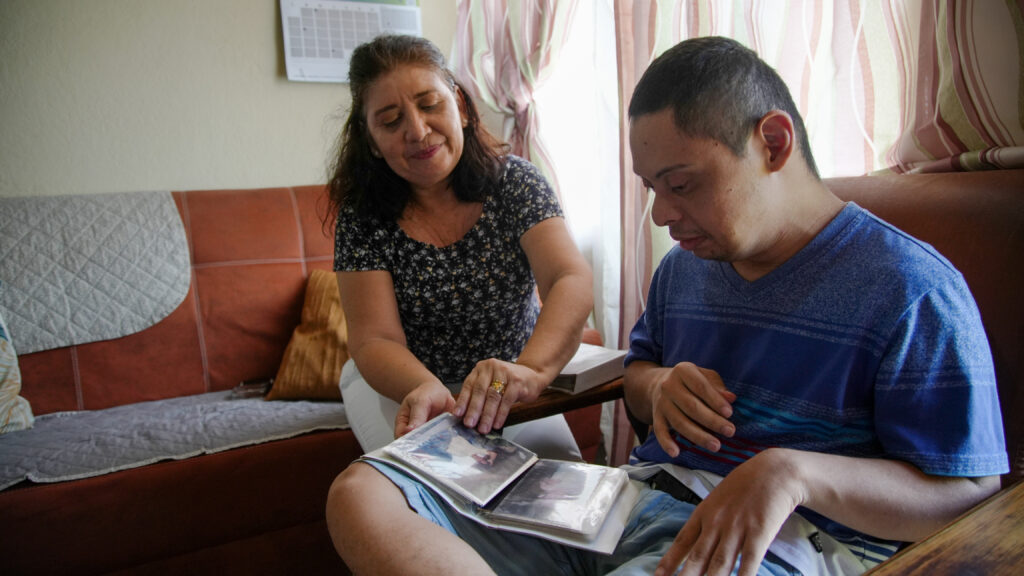
Vilma Segura is one of hundreds of women who are dedicated to caring for someone who is dependent, but her tasks are not recognized as work. Photo: Rubén F. Román
What is being done to address these situations?
Local educational centers and institutes such as UNA, the University of Costa Rica and INA have alliances with municipalities, foundations and organizations to provide training and courses focused on the English language.
The province’s chambers of commerce and of tourism work together with public and private institutions to improve the work training of Guanacastecans.
“We’re working to have institutions commit to the issue of bilingualism. For us, mastery of a second language is very important, hopefully English,” said Rebeca Álvarez, director of the Guanacastecan Chamber of Tourism Association (Spanish acronym: CATURGUA).
According to Carlos Villegas, from the central office of INA’s Vocational Training Center in Liberia, the majority of people enrolled in courses are women. He stated that the permanent staff don’t manage to supply all of the regional demand in tourism and the English language.
According to data from INA on programs completed in the Chorotega Region Unit in 2023, a total of 791 people enrolled in English courses, Of these, 288 are men and 503 are women, which is 63% of them. However, this is not reflected in the workplace.
According to the National Employment Agency (Spanish acronym: ANE), a platform of INA’s that serves as an intermediary between people looking for work and companies that offer employment, INA allocated enrollment capacity of around 5,000 for Guanacaste in areas of high labor demand such as: English, cybersecurity, cooking, programming, IT Essentials and Networking. People interested in the courses need to register and select “Búsqueda de Cursos” (Course Search).
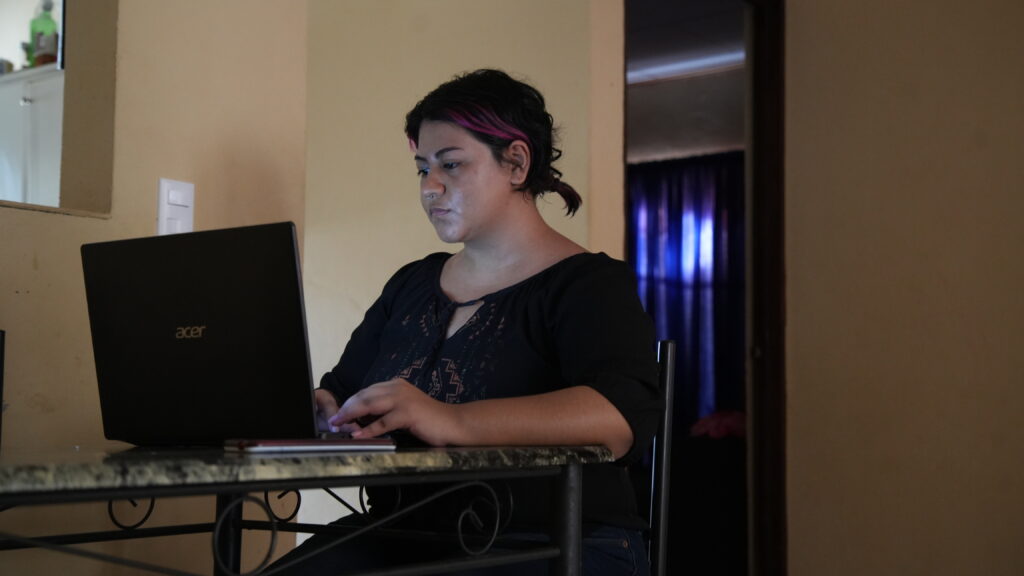
Lithzi Araya studies English in hopes of meeting market expectations. Photo: Rubén F. Román
Lithzi Araya is a student at INA’s Liberia campus. She’s taking English training remotely and is very satisfied. “Each person should have at least a B1 level because that’s a requirement in several jobs.” She’s at the upper intermediate English level.
Among the programs with the most graduates in the Chorotega region in 2022, according to INA, are: Information Technology Operator (239 graduates), Basic English (153 graduates) and Conversational English for Business (149 graduates).
Alejandro Sandí, head of ANE, said that there are around 2,039 women from Guanacaste registered on the platform. He mentioned that there is a high demand for jobs in Guanacaste in commerce and services and tourism and in some cases, they require English.
Among the jobs that are available in Guanacaste are: call centers; related to hospitality, construction work, waitressing, miscellaneous and the food industry.
“With these public employment statistics, the information is transferred to the Employment Council (within the National Employment System), which is in charge of creating guidelines and policies and this way, decisions can be made,” said Sandí.
The Employment Council is part of the governance of the National Employment System’s policy management.
The National Strategy for Employability and Human Talent, known as “Brete” (job), announced in July in Guanacaste promoted an inter-institutional cooperation agreement between the Ministry of Labor and Social Security (MTSS) and the Tamarindo Chamber of Tourism and Commerce.
“It allows the workforce to be more trained, to be more efficient, to have greater opportunities and in this way begin to close those gaps in the near future. That’s the idea of the employment unit,” said Álvaro Oviedo, in charge of the employment, security and training area of the Tamarindo Chamber of Tourism and Commerce.
INA has a Gender Equity and Equality advisory department that helps women achieve a broader perspective, to train in non-traditional areas, with high labor demand.
Among the areas defined by the institution as having the greatest labor demand and the most gender asymmetry are: vehicle mechanics, metalworking, electrical service and nautical fishing. The advisory department also encourages women to enroll in training, as well as maintaining timely support to avoid participant dropout.
I believe a lot in technicians. Nowadays it helps them to position themselves very early in the market and very quickly,” said Mariela Guzmán, member of the Tilarán Chamber of Commerce, Industry and Tourism.
What about local governments?
Municipalities promote training, job fairs and entrepreneurship fairs as a way to connect their inhabitants with job options.
“We have an entrepreneurship association in the canton that is made up of more than 80 entrepreneurs,” said Arianna Badilla, vice mayor of the Municipality of Liberia.
In Hojancha, they suggest that women venture into entrepreneurship. “There is a lot of work done with workshops to form a company,” said Cindy Guevara, coordinator of the Hojancha Women’s Office.
Allan Carmona, in charge of employment intermediation for the Municipality of Santa Cruz, suggests that the population be trained in English so that they can adapt to job market requirements. He mentioned that Azucarera El Viejo and hotels are among the large companies in the canton. “As an employment office, we are trying to reach the most vulnerable population to motivate them to get training and study,” Carmona highlighted.
What’s needed and why isn’t it done?
The people interviewed suggeste a change in Guanacaste to diversify the economy in order to not depend solely on tourism and agricultural activities.
“Tourism is very dependent on international fluctuations,” commented UNA researcher Esteban Barboza.
To Xinia Carrillo, organizations should improve their strategies for supporting people.
Marcia Meza is part of the Hojancha farmer’s market. She sells pastry products there and from her home. “We need a little more diffusion; we need more help from institutions,” she remarked.
Ángel Guevara, vice president of the Territorial Council of Rural Development of Cañas, Bagaces, Tilarán and Abangares at the National Institute of Rural Development (Spanish acronym: INDER) said that “the social, private and institutional actors are not put together to promote production chains, especially in the cantons at high elevations.”
They also agree that each person should analyze their skills and, in this way, improve their professional training in such a way that it adapts to job options in the region.
We don’t do anything if there’s an investor with a lot of money and we have the infrastructure, if we don’t have the personnel that can cover those needs,” commented Álvaro Oviedo, in charge of the employment, security and training area of the Tamarindo Chamber of Tourism and Commerce.
María Picado, from INAMU, talked about taking it a step further, towards STEM careers (science, technology, engineering and mathematics) to expand job opportunities.
Invenio University, located between Cañas and Tilarán, ventured into Guanacaste with the dual model where STEM careers are offered.
Yenory Rojas, dean of Invenio University, expressed interest in attracting more women, given that a smaller percentage of the female population enrolls in these types of professions.
“Women who study engineering receive up to a 50% discount on their entire degree program because our goal is to increase the female population,” she commented.
However, these are all long-term solutions for the women of Guanacaste who don’t yet have the ideal professional profiles for the jobs that become available in the region.
Much like attracting foreign investment from companies and diversifying the economy, everything involves adequately bringing together institutions, public and private organizations, in order to promote Guanacaste’s development.
This article was prepared as part of the Punto y Aparte program, which connects young student journalists with experienced ones.



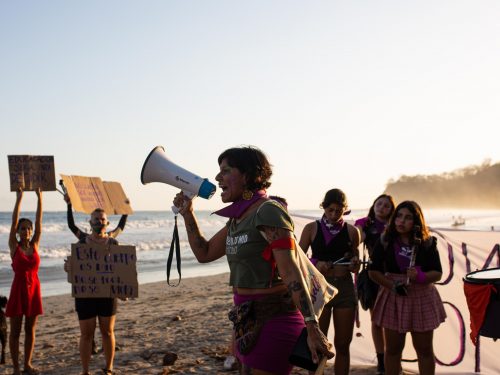
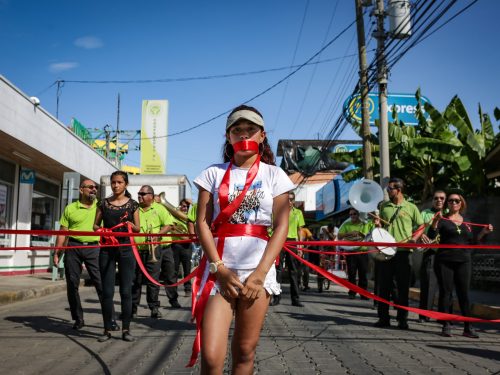


Comments